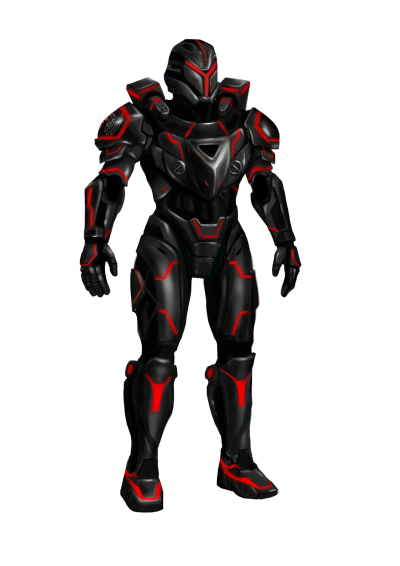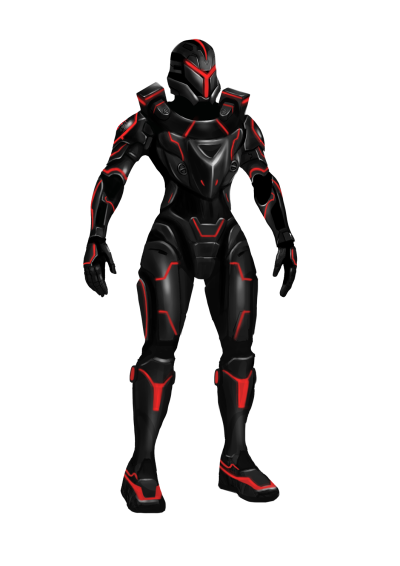Table of Contents
Revenant Power Armor R1-SPA
Or also known as “Revenant” power armor, It is a suit designed by Section 6 in YE 39 for use by Saber units, a special forces department of Section 6 for the OSO. The armor is a basic tri-layered suit, with attachable armor units, and secondary systems. It is meant to provide maximum protection against various weapon types, and has advanced stealth technology, but still allows the user as much flexibility as possible.
In YE 43 it was officially replaced in widespread useage by the Revenant Power Armor Mk II, though it remains in use with special forces groups.
About the Armor
Designed to provide Saber members with mobility, protection, and stealth capabilities for operation in dangerous environments behind enemy lines. the armor is also modular, allowing for ease of repair and upgrading. Saber teams need to be able to move fast, strike decisively, and be highly covert when the situation requires, the R1-SPA fills all these criteria.
Statistics & Performance
Here is the manufacturing data on the Mk I.
- Class: BW-PA-1A
- Manufacturer:Department Of Engineering, Black Wing Enterprises
- Fielded by: New Dusk Conclave
- Range: 2 months
- Maintenance Cycle: Preferably after every mission, but 2 months if in extended use.
- Lifespan: 10 years
Appearance
The base suit looks like a sort of thick black body suit that covers the user from the chin down and the lower back of the head, with visible patches where the armor is attached. these patches are smooth compared to the hexagonal texture of the rest of the suit, and there is an upside down y shaped seam that is on the front of the torso where the suit opens to allow the user to get in and out. the suit seals and unseals through a control located on the suit's wrist. There are seal locks on the edge of the suit that comes up to the wears chin, where the helmet seals after being put on for protection against environmental hazards. The hands and feet look like they are covered in a segmented carapace like version of the same material of the rest of the suit. Finally on the back of the suit is what appears to be an almost looks like a flattened metal spine hugging along the user's spine, which has small lights in between each “vertebrae”.
The torso armor is very convex in design in the front, almost like a hexagonal hump. It is not rounded, but edged in shape, with six visible sides to the chest area. It stops above the lower mid section, where the back section of the armor stops above the lower back. The back has two medium diagonally oriented thruster units built into the back, with a sort of vertical hump in between them that contains the power source, life support, and an additional shielding unit. A visible clamp is under each arm, and over both shoulders, which is how the armor is fastened on, and an armored plate moves from the top of the armored back to cover the back of user's neck.
The arm armor consist of the gauntlets which look like armored gloves which are thicker on the back of the hand due to built in kinetic buffers, and there are armored segments magnetically attached to the back of the fingers and palm. The forearm armor is a shell that is conformed to the user's forearm that is split in two that magnetically clasp together, with a edged six sided elbow guard similar in appearance as that of the torso armor. Finally the upper arm is likewise covered in a cased armor shell, but with a reinforced pauldron with a built in kinetic buffer.
The leg armor includes the thigh pieces, lower leg, and boots. The thigh pieces similarly like the arm armor is shaped to the suit with the top of the hip uncovered to prevent hindrance of movement. The lower leg piece is edged instead of rounded, with a sort of vertical rectangular shape that looks like a has been shaped to fit a humanoid leg. flat and slightly bent to fit to the shape of a leg, with the sides rounded. The knee guard looks like a hexagon with a three sided piece removed from the top side. Finally the boots are armored plates in the shape of front of a boot and the back of the heel. Two reinforced armor plates that are shaped like to halves of a metal boot cover the sides, leaving only a strip of the front armored plate visible. when not worn, the plates are exploded out, and retract to enclose the users suited feet when stepped into.
The groin armor is a reinforced utility belt for attaching pouches or other containers for ammo and items, and a curved piece of armor running from the front to the back between the legs, and a cushioned armor plate covering the rear.
The helmet a three sided curved top, with a full face visor, two armor plates that are rhombus shaped that are bent around the sides which are moved to cover most of the visor making it look Y shaped in appearance for combat. The mouth or lower face section of the front of the helmet is covered with a stretched trapezoid shaped extension that has vents where the mouth would be. Finally the back of helmet includes a data jack port and a slot for chips and data modules, and the helmet does not cover the lower back of the head itself.
Advantages
The R1-SPA provides strong protection and increased strength, while also still able to be very agile and flexible.
Drawbacks
To provide such mobility, there is only a light power armor level of protection provided by the armor.
Mobility
The armor is designed to be Light in weight, equipped with thruster modules, as well as provide a greater range of movement, and flexibility.
- Ground Speed (Running): 60 mph
- Ground Speed (Hovering): none
- Max. Atmospheric Speed: 90 mph
- Max. Sublight: 0.1c
Armor Size
| Height | 6'6 feet or 2 1/3'2 meters (subject to user's height) |
|---|---|
| Width | 3 feet or 1 meter |
| Length | 1 foot or 1/3 meter |
| Weight | 420 lb |
Damage Capacity Stats
See Damage Rating (Version 3) for a guide to damage ratings to include.
- Body: Light power armor (DRv3 tier 4)
- Shield System: bubble shields rated for light power armor (DRv3 rated tier 4)
Getting In and Out
The torso seal of the base suit splits opens to allow the user to slip in to the suit, the synthetic muscles then stimulate conforming the suit to the user's body. Then the armor pieces are easily magnetically attached on with or without mechanical assistance. Finally just picking up the helmet and putting it on and activating it's seals to complete full equipment of the suit.
Controlling the Armor
Movement and use of the suit is stimulated by the slight movements of the users body. Sealing, unsealing, and removal of the armor pieces can be activated by a control located on the base suit's wrist.
History
Jack Pine met with his engineering and weapons division to come up with a specialized suit of power armor that would fit the various high standard needs for the extremely hazardous condition they would have to deal with on operations. And thus the R1-SPA was designed and developed in Section 6 labs and workshops, and to now only recently enter field testing.
Systems
Propulsion
The back of the torso armor as well as the back of the leg armor is equipped with integrated thruster modules. They do not allow sustained flight for more than ten seconds. The pair included on the back are high output, while the units in the back of the legs are low output. These allow for high jump heights, accelerated scaling of walls/cliffs, high altitude landing, increased forward movement speed, short evasive maneuvers, as well greater mobility in dealing with obstructions and obstacles.
Armor
The base suit is composed of of three layers, a layer of synthetic muscle in between two layers of kinetic, and energy resistant gel. In between each layer and the exterior are thin layers of nano weaved Usonium. Providing complete protection from Pistols, shotguns, SMG's, and fragmentation. It is resistant to energy weapons, and rifles, anything large will not be stopped by the suit.
The armor components that are magnetically attached to the base suit are made a of a light, but strong composite with embedded layers of nano-weaved usonium.
Camouflage
The R1-SPA features an experimental stealth technology called E.C.S.(Electronic Camouflage System), or active camouflage.
Life Support
The suit features life support, temperature control, and emergency medical systems located in the back section of the torso armor. Life support can sustain a person in space, or hazardous environments for at least three weeks. Temperature control systems ensure the user is kept in comfortable temperature conditions for harder temperature climates and to ease exhaustion from physically demanding activity.
Emergency Medical
Emergency medical systems include the administering of coagulants and sealants to where ever needed in the suit through administration tubes that run through out the base suit. This module of the torso back section is also capable of administering pain medication if needed. Also a small defibrillation unit is built into the chest area of the armor, for use if the user registers as flat lining. Finally an experimental technology is being researched to allow the suit to put the user in a stasis like state upon major critical injury.
Power Systems
The back of the Torso armor module contains two Aether taps to power the full suit with emergency power packs that can be recharged through thermal and kinetic energy conversion, and the base suit uses the user's body's own bio-electric discharge, kinetic energy, and thermal energy given off to provide what little energy is needed by the base suit.
Sensors and Communications
The helmet is equipped with a full suite of optical, IR, UV, and Low light sensors, with seismic sensors located in the boots. Communications include Satellite(if available), video, suit to suit relay, tight beam(limited to the direction of the beam), and standard radio(1LY range).
Weapons
Weapon systems currently are limited to standard hand weapons carried by un-powered armor personnel, as well as normal PA carried hand weapons.
Hardpoints
Currently the only hard points are those of the armor pieces attachment points, all other systems are built in. Further accessories are to be researched and upgraded in the future.
OOC Notes
Jack Pine created this article on 2017/08/05 13:27.
Approval thread: https://stararmy.com/roleplay-forum/index.php?threads/spectre-prototype-power-armor.49792/
Art by banzz

